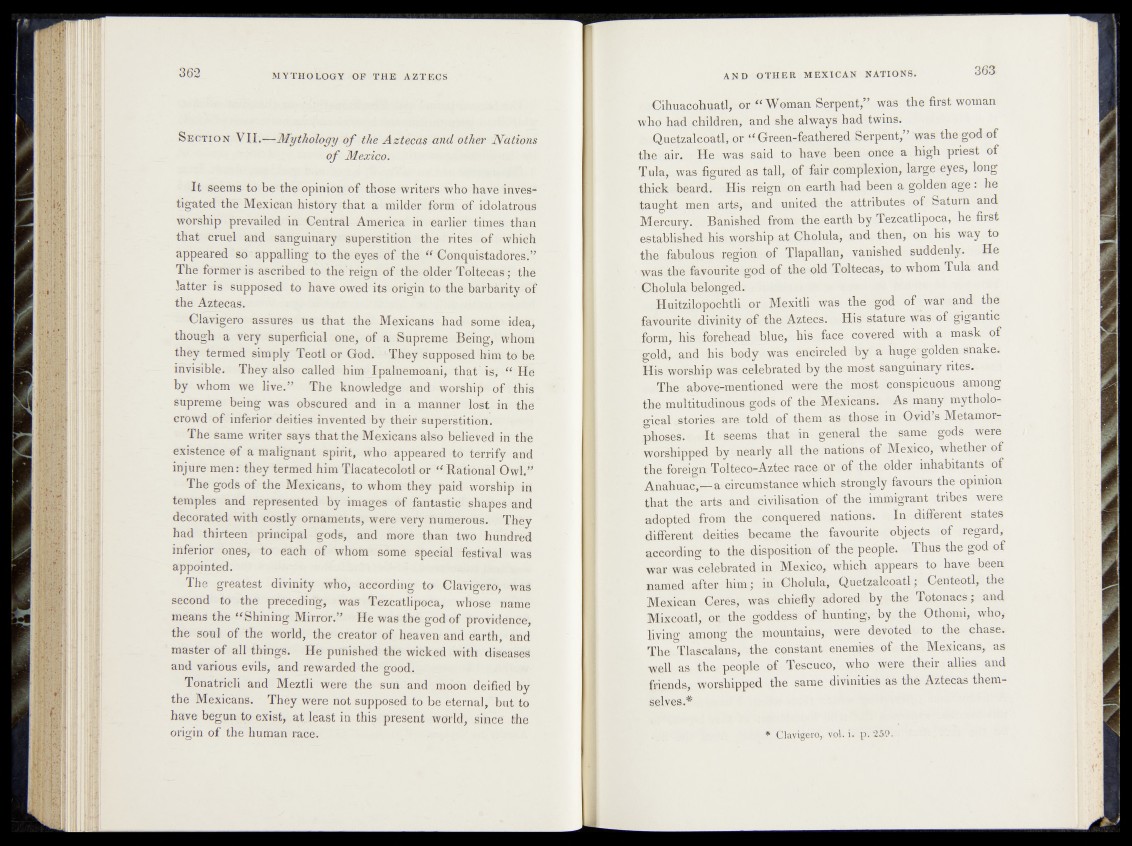
S e c t io n VII.—Mythology o f the Aztecas and other Nations
o f Mexico.
It seems to be the opinion of those writers who have investigated
the Mexican history that a milder form of idolatrous
worship prevailed in. Central' America in earlier times than
that cruel and sanguinary superstition the rites of which
appeared so appalling to the eyes of the “ Conquistadoresi”
The former is ascribed to the reign of the older Toltecas; the
latter is supposed to have owed its origin to the barbarity of
the Aztecas.
Clavigero assures ns that the Mexicans had some' idea,
though a very superficial one, of a Supreme Being, whom
they termed simply Teotl or God. Theysupposed him to be
invisible. They also called him Ipalnemoani, that is, “ He
by whom we live.” The knowledge and worship of this
supreme being was obscured and in a manner lost in the
crowd of inferior deities invented by their superstition.
The same writer says that the Mexicans also believed in the
existence of a malignant spirit, who appeared to terrify and
injure men: they termed him Tlaeateeolotl or “ Rational Owl.-
The gods of the Mexicans, to whom they paid worship in
temples and represented by images of fantastic shapes and
decorated with costly ornaments, were very numerous. They
had thirteen principal gods, and more than two hundred
inferior ones, to each of whom some special -festival was
appointed.
The greatest divinity who, according to Clavigero, was
second to the preceding, was Tezeatlipoca, whose name
means the “ Shining Mirror.” He was the god of providence,
the soul of the world, the creator of heaven and earth, and
master of all things. He punished the wicked with diseases
and various evils, and rewarded the good,
Tonatricli and Meztli were the sun and moon deified by
the Mexicans. They were not supposed to be eternal, but to
have begun to exist, at least in this present world, sines the
origin of the human race.
. Oihuacohuatl, or “ Woman Serpent,” was the first woman
who had children, and she always had twins.
Quetzal coati, or “ Green-feathered Serpent,” was the god of
the air. He was said to have been once a high priest of
Tula, was figured as tall, of fair complexion, large eyes, long
thick beard. His reign on earth had been a golden age : he
taught men arts, and u n i t e d ‘the attributes of Saturn and
Mercury. Banished ferm the earth by Tezeatlipoca, he first
established his worship at Cholula, and then, on his way to
the fabulous region o f Tlapallau, vanished suddenly. He
was the favou rite god of the old Toltecas, to whom Tula and
Cholula belonged.
Iluitzilopochtli or Mexitli was the god of .war and the
favourite divinity of the Aztecs. His stature was of gigantic
form, his forehead blue, bis face covered with a mask of
goldr and Ifer body was encircled by a hfege'gdlden snake.
His worship was celebrated by the most sanguinary rites.:•
The above-mentioned were the most conspicuous among
the multitudinous gods of the Mexicans. As many mytholo^
gical .stories are told of them as those in Ovid’s Metamorphoses.
It seems that in general the same gods were
worshipped by nearly all the nations of Mexico, whether of
the foreign Toltéco-Aztoc race or of the older in h ab itan ts^
Anahuac,—a circumstance which strongly favours the opinion
that the arts and civilisation of the immigrant tribes were
adopted frôm the conquered nations* In different states
different deities became the favourite objects of regard,
according to the disposition of the people. Thus the god of
war was celebrated in Mexico, which appears to have been
named after him; in Cholula, Quetzalcoatl; Centeotl, the
Mexican Ceres, was chiefly adored by the Totonaes ; and
Mixcoatl, or. the goddess of hunting,- by the Othonu, who,-
living among the mountains, were devoted to the chase*
The Tlascalans, the constant enemies of the Mexicans, as
well as the people of Tescuco, who were their allies and
friends, worshipped the same divinities as the Aztecas themselves.*
Clayigera,. vol. i. p. 259.